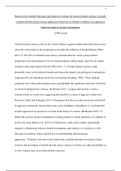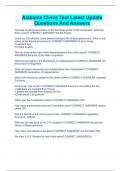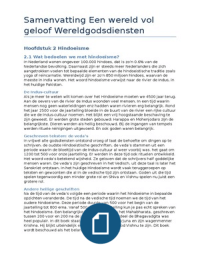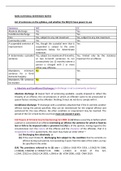1
Based on the available literature and empirical evidence on alcohol-related violence, critically
evaluate whether alcohol causes aggressive behaviour or whether a tendency for aggressive
behaviour leads to alcohol consumption.
(2460 words)
Alcohol related violence refers to the violent offences against another individual which occur
when the victim believes the perpetrator to be under the influence of alcohol (Home Office
2015: 3). The 2013/14 British Crime Survey estimates that the victim perceived their
perpetrator to be intoxicated in 51% of violent incidents without injury, and 57% of violent
incidents with minor injuries (Home Office 2015: 7). Alcohol related violence could
potentially cause severe physical trauma and long-term negative psychological consequences
experienced by all individuals involved in an incident (Golding, 1999). These findings
emphasise how often such incidents occur and highlights the significant risk factor of alcohol
on levels of interpersonal violence. McMurran (2012: 3) argues that alcohol is often a
common factor in violent acts, suggesting that alcohol is a cause of aggressive behaviour.
However, Finkel and Eckhardt (2013: 189) propose that there are other processes which lead
to aggressive behaviour, and alcohol is not a sole contributor. Nonetheless, it was found that
alcohol appeared to be present in over half of all crimes of violence (McMurran 2012: 15).
While this portrays alcohol consumption as being present in violent incidents, it is unlikely to
be the sole cause (Babor et al. 2010: 6). Furthermore, while such evidence undoubtedly
supports a relationship between alcohol consumption and violence, it is unclear as to the
direction of causality, which could be key in understanding and preventing
aggression. Therefore, this report will examine the available literature on alcohol related
violence and investigate if alcohol directly causes violence or if there are other possibilities as
to why violence may occur when alcohol is present.
, 2
There is a plethora of research into the association between alcohol use and violence, and it
has commonly been reported that alcohol is a significant contributor in violent acts (Abbey
2011: 363; McMurran 2012: 3; Testa et al. 2012). Chermack and Giancola (1997: 622) and
Aldridge, Measham and Williams (2013: 60) support this research and have additionally
stated that perpetrators of violent crimes had often consumed alcohol shortly before the
incidents. To further support these findings, Graham et al. (2011: 1504) reported that an
increase in alcohol usage was associated with an increase in severity of the level of
aggression shown in violent incidents. International investigations have also reported similar
findings: Liem et al. (2013: 84) concluded that, when examining Finnish homicides, in 83%
of the cases one of the individuals involved were intoxicated with alcohol.
Additionally, Landberg and Norström (2011: 724) found that an increase in alcohol
consumption was associated with an increase in homicides of about 10% in both Russia and
the USA. In contrast, Ramstedt (2011: 1) reported that when control of alcohol consumption
was introduced throughout Australia, homicide levels also decreased. Although these studies
were conducted in different countries, it is possible to conclude that the association between
alcohol consumption and incidents of violence is similar in separate countries, suggesting that
alcohol does have a significantly negative impact on aggressive behaviour. Additionally,
longitudinal studies reported that individuals who began to consume alcohol at a young age
would often become involved in violent crimes by the age of 23 (Ellickson, Tucker, and
Klein 2003: 951; Viner and Taylor 2007: 908). These findings all suggest that alcohol does
have a significant impact on the probability and severity of violence. However, Bye and
Rossow (2010: 132) found that the number of fights amongst teens per 1,000 drinking
occasions were significantly low, between two and ten. This counteracts aforementioned
research findings by highlighting that alcohol does not predominantly cause violence in every
occasion. It also shows that the relationship between alcohol and violence is conditional; it
, 3
depends on the context of the situation and other factors such as personal temperaments,
situational factors such as provocation, and external personal issues (family problems,
relationship issues, money issues) amongst the individuals drinking. While these findings
provide an alternative argument for alcohol related violence, only a small sample of teenagers
were used which cannot necessarily be generalised to the wider population and other
individuals worldwide, nor do the findings establish a causal effect of alcohol related
aggression.
There are many different forms of alcohol related violence, including verbal aggression,
sexual and interpersonal assaults, domestic abuse, accidental injury, accidental death, and
homicides (Schnitzer et al. 2010). One relatively common form of violence is sexual assault,
which can be defined as ‘a sexual act that is conducted against someone’s will’ (Centres for
Disease Control and Prevention 2010). It has been reported that 40-75% of perpetrators of
sexual assault had consumed alcohol (Abbey 2011: 364;). Parkhill, Abbey, and Jacques-Tiura
(2009: 333) also highlighted that more severe incidents of sexual assault occurred when the
perpetrator had been heavily drinking, thus emphasising a strong association between alcohol
and sexual violence. Alternatively, O’Farrell et al. (2003) acknowledged that alcoholic males
who were undertaking treatment for alcohol usage were found to be four times more likely to
perpetrate domestic violence than non-alcoholic males. These findings suggest that alcohol
increases the probability of intimate partner violence occurring, whether it be sexual or
domestic, and also shows that the severity of violence against the victim is likely to increase
alongside the level of intoxication, which suggests that alcohol does cause aggression and
also influences the level of aggression displayed by the offender.













